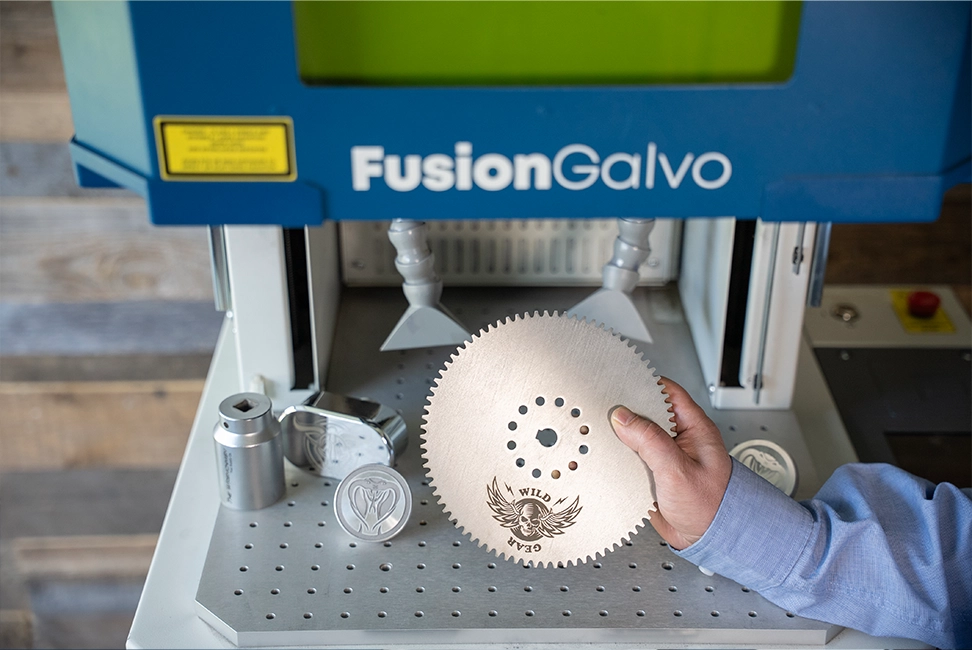Markieren von Automobilteilen mit Faserlasermaschinen
In der Automobilindustrie werden sowohl Flachbett-Faserlaser als auch Galvo-Faserlaser für verschiedene Fertigungsprozesse eingesetzt. Faserlaser werden im Automobilbau eingesetzt, um Teile und Komponenten dauerhaft mit Seriennummern, Logos, Barcodes und vielem mehr zu versehen. Sie können Metall- und Nichtmetallmaterialien markieren und ätzen, was sie für Automobilhersteller sehr nützlich macht.
GEEIGNETE MATERIALIEN
Die Ingenieure entwickelten sowohl Faser- als auch Galvo-Lasermaschinen zur Markierung von blanken Metallen und einer Vielzahl von technischen Kunststoffen. Zu den gängigen Materialien, die mit einer Faser- und/oder Galvolasermaschine markiert werden, gehören:
- Metalle: Edelstahl, Aluminium, Kupfer, Messing, Titan, Gold, Silber, Platin und mehr.
- Kunststoffe: Kunststoffe: ABS, Polycarbonat, Acryl, Polyethylen und mehr.
- Technische Materialien: Siliziumwafer, Kohlenstoffverbundwerkstoffe usw.
Gängige Laseranwendungen in der Automobilindustrie
Hersteller verwenden Flachbett-Faser- oder Galvolaser zur Markierung von Autoteilen, da sie genau, schnell und flexibel sind. Hier sind einige gängige Anwendungen, die in diesen beiden Arten von Lasern durchgeführt werden können.
Seriennummern und VIN-Kennzeichnung
Autoteile können eine eindeutige Seriennummer oder VIN zur Verfolgung und Qualitätskontrolle haben. Die Seriennummer oder VIN identifiziert jedes einzelne Teil. Dies trägt dazu bei, dass das Teil den Qualitätsstandards entspricht. Es hilft auch, das Teil während des gesamten Herstellungsprozesses zu verfolgen.
Barcodes und QR-Codes
Die Lasermarkierung von Barcodes oder QR-Codes auf Automobilteilen hilft bei der automatischen Verfolgung. Es hilft auch bei der Verwaltung des Bestands und der Qualitätssicherung in der Lieferkette
Konformitätskennzeichnung
Autoteile müssen gekennzeichnet werden, um Regeln wie CE-Kennzeichnung, RoHS-Konformität oder Sicherheitszertifizierungen zu erfüllen. Faserlaser können Compliance-Symbole, Logos oder Texte genau auf Teilen markieren.
Maßnahmen zur Bekämpfung von Fälschungen
Die Lasermarkierung kann dazu beitragen, gefälschte Produkte zu verhindern, indem sie Autoteile mit Sicherheitsmerkmalen ausstattet. Zu diesen Funktionen können kleine Texte, Geheimcodes oder Markierungen gehören, die anzeigen, ob jemand die Teile manipuliert hat. Dies hilft, Fälschungen zu verhindern.
Teile-Identifizierung
Die Beschriftung von Teilen mit Nummern hilft bei der Identifizierung während der Montage, Reparatur und Wartung.
Logo und Branding
Laser können Logos, Markennamen oder andere Branding-Elemente auf Automobilteilen anbringen
Datums- und Zeitstempel
Das Angeben von Daten auf Autoteilen hilft, den Überblick über den Bestand und die Garantien zu behalten.
Laser-Oberflächentextur
Durch die Laser-Oberflächentexturierung können Autoteile wie Bremsbeläge, Kupplungsscheiben und Zahnräder weniger Reibung aufweisen. Dies kann dazu beitragen, dass sie bessere Leistungen erbringen und länger halten.
Rückverfolgbarkeit von Materialien
Die Kennzeichnung von Materialien, die in Automobilteilen verwendet werden, wie z. B. die Legierungszusammensetzung oder die Materialqualität, liefert wichtige Informationen für Recycling-, Wartungs- und Reparaturprozesse.
Montagehilfen für Baugruppen
Die Lasermarkierung kann beim Zusammenfügen von Autoteilen helfen, indem sie Anweisungen, Anleitungen oder Markierungen auf den Teilen anzeigt. Das erleichtert die Montage und reduziert Fehler.
Die perfekte Wahl
Flachbett-Faser- und Galvo-Faserlasersysteme können Materialien für die Automobilherstellung schnell und präzise markieren. Sie können Metalle, Kunststoffe, Keramiken und Verbundwerkstoffe präzise markieren. Diese Eigenschaften machen sie zu einer idealen Lösung für verschiedene Anwendungen zur Kennzeichnung von Automobilteilen.
KUNDEN IM RAMPENLICHT:
Welche Arten von Noten können Sie erzielen?
Gravieren Sie schnell und einfach eine Vielzahl gängiger Marken
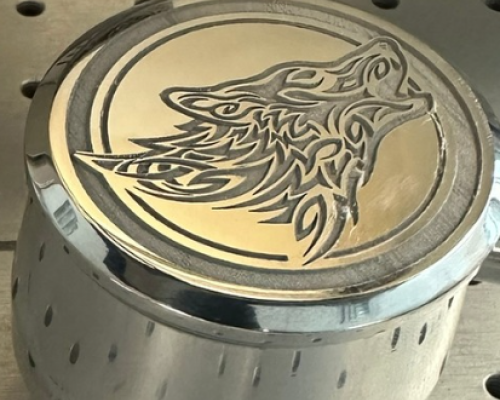
laserbeschriftung
Ätzen wird häufig für industrielle Zwecke verwendet, um Werkzeuge oder Teile mit Seriennummern, Logos und Barcodes zu kennzeichnen. Durch den Ätzprozess wird Material vom Metall entfernt. Material wird abgeführt, um eine Markierung wie einen Barcode oder Datamatrix-Code zu hinterlassen. Dadurch entsteht durch eine flache Gravur eine deutliche Markierung auf dem Metall.
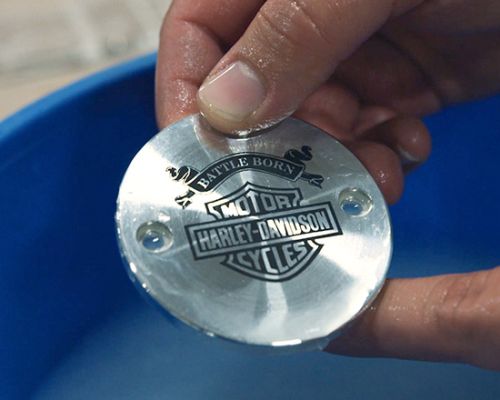
tempern
Eine geglühte Markierung ist wie der Polierprozess. Der Laser erhitzt das Metall bis nahe an den Schmelzpunkt, wodurch sich die Farbe der obersten Materialschicht ändert. Je nach Metallart ergibt das Glühen oft eine dunkle, fast changierende Optik. Auf ähnliche Weise können Sie die Parametereinstellungen für Faser und Galvo verwenden, um gezielt unterschiedliche Farben auf bestimmten Materialien zu erzeugen.
Da kein Material vom Metall entfernt wird, wird diese Technik häufig für medizinische Geräte verwendet, die im menschlichen Körper verwendet werden. Beim Glühen entsteht im Gegensatz zum Markieren und Ätzen eine dunkle Markierung ohne Schnitte oder flache Gravuren.

polieren
Ein Laserstrahl erhitzt die Oberfläche des Materials, um poliertes Metall zu erzeugen, das auch als "verspiegelt" bezeichnet wird. Anschließend kühlt die Oberfläche ab, was zu einem glänzenden Finish führt. Diese Technik ist am häufigsten auf mattem Metall zu finden und erzeugt Markierungen, die fast holografisch aussehen können.
Im Gegensatz zum Ätzen verändert die Hitze die Oberfläche des Metalls, ohne dass Material entfernt wird. Der polierte Look findet sich häufig auf ausgefallenen Schildern und hochwertigen Produktetiketten. Es wird verwendet, um ihnen ein raffiniertes und einzigartiges Aussehen zu verleihen. Das verspiegelte Finish erzeugt eine Ton-in-Ton-Optik, indem das Metall markiert wird.
Menschen verwenden diese Technik auch auf schwarzem Oxid oder ähnlich dunkel beschichteten Metallen. Sie können die Oxid-/Schwarzbeschichtung aufhellen, indem Sie die Einstellungen anpassen. Dadurch wird die Farbe des darunter liegenden Metalls sichtbar. Das Ergebnis ist ein kontrastreiches Ton-in-Ton-Erscheinungsbild.
Gängige Metalle für die Markierung mit Epilog Laser-Faser- oder Galvo-Maschinen
Eloxiertes Aluminium
Die Lasergravur von eloxiertem Aluminium mit einem Epilog Laser-Gerät ist eine hervorragende Möglichkeit, klare, langlebige Markierungen auf Metall zu erzeugen. Beim Eloxieren wird dem Aluminium eine farbige Schutzschicht hinzugefügt, und der Laser entfernt diese Schicht, um das darunter liegende leichtere Metall zu zeigen. Dadurch entsteht ein scharfer Kontrast, der sich gut abhebt.
Die gravierten Markierungen sind dauerhaft und beständig gegen Verschleiß, Witterungseinflüsse und Chemikalien. Dies macht den Prozess ideal für das Hinzufügen von Logos, Seriennummern, Barcodes oder Designs zu Dingen wie Elektronik, Werkzeugen und Schildern. Sowohl CO2- als auch Faserlaser können eloxiertes Aluminium sehr effizient und mit hoher Präzision markieren und sind damit ideale Optionen für die Beschriftung von Metalloberflächen.
Edelstahl
Das Markieren von Edelstahl mit den Faser- oder Galvomaschinen von Epilog bietet erhebliche Vorteile in der gesamten Automobilindustrie.
Bei der Markierung mit einer faser- oder galvobasierten Lasermaschine können Benutzer dauerhafte und dauerhafte Markierungen auf Edelstahlteilen und -komponenten erwarten. Diese Lasermarkierungen sind beständig gegen Verschleiß, Chemikalien, Hitze und Korrosion und eignen sich daher ideal für raue Umgebungen und kritische Rückverfolgbarkeit.
Faser- und Galvo-Lasermaschinen markieren Edelstahl mit unglaublich hoher Präzision und Detailgenauigkeit und stellen sicher, dass Barcodes und QR-Codes auch zu Tracking- und Tracing-Zwecken problemlos gescannt werden können.
Titan
Die Lasermarkierung von Titan mit einer Epilog-Maschine bietet mehrere entscheidende Vorteile, insbesondere bei der Herstellung von Hochleistungs-Autoteilen, bei denen sowohl Leistung als auch Konformität eine Rolle spielen.
Titan bildet von Natur aus eine schützende Oxidschicht, die durch Lasermarkierung (insbesondere Glühen) verstärkt wird. Auf dieser Art von Metall erzeugen Faser- oder Galvolaser Markierungen, die chemisch stabil, biokompatibel und abriebfest sind.
Was sind die Unterschiede zwischen Flachbett-Faserlaser- und Galvo-Faserlasermaschinen?
Flachbett-Faserlaser und Galvolaser sind zwei Arten von Lasersystemen, die für unterschiedliche Anwendungen eingesetzt werden. Sie unterscheiden sich in ihrem Design, ihren Fähigkeiten und ihren geeigneten Anwendungen.
Lasersystem: |
Flachbett |
Fusion Galvo |
Entwurf: |
|
|
Geschwindigkeit/Präzision: |
|
|
Warum ist die Lasermarkierung besser als die Nadelprägung?
-
Hohe Präzision
Die Lasermarkierung ist präzise und eignet sich perfekt für die Erstellung detaillierter Designs, kleiner Texte und Grafiken ohne Verzerrung. Die Nadelprägung ist zwar präzise, kann aber bei der Erzielung feiner Details eingeschränkt sein, insbesondere bei gekrümmten oder unregelmäßigen Oberflächen.
-
Berührungsloses Verfahren
Die Laserbeschriftung ist ein berührungsloses Verfahren, d.h. das Markierwerkzeug berührt das Werkstück nicht. Dies verringert das Risiko, empfindliche Teile zu beschädigen, und verringert die Wahrscheinlichkeit von Fehlern. Bei der Nadelprägung wird die Oberfläche direkt berührt.
-
Vielseitigkeit
Sie können viele verschiedene Materialien wie Metalle, Kunststoffe, Keramiken, Verbundwerkstoffe und mehr markieren. Diese Systeme erfordern nicht viele Setup-Änderungen. Bei der Nadelprägung können Anpassungen für unterschiedliche Materialien oder Oberflächen erforderlich sein. Auf der anderen Seite bietet die Laserbeschriftung mehr Flexibilität und kann sich an verschiedene Fertigungsanforderungen anpassen.
-
Geschwindigkeit und Effizienz
Die Lasermarkierung ist schneller als die Nadelprägung, insbesondere bei komplizierten Designs oder großen Teilechargen, was die Geschwindigkeit erhöht. Lasersysteme können hohe Markiergeschwindigkeiten bei gleichbleibender Qualität und Präzision erreichen, was zu einem höheren Durchsatz und einer höheren Produktivität in der Automobilfertigung führt.
-
Qualität und Ästhetik
Die Lasermarkierung erzeugt schön aussehende Markierungen mit glatten Kanten und Kontrasten, wodurch die markierten Teile besser und wertvoller aussehen. Die Nadelprägung ist zwar langlebig, kann aber Markierungen mit raueren Kanten und einem weniger gleichmäßigen Aussehen erzeugen, insbesondere auf bestimmten Materialien.
-
Keine Verbrauchsmaterialien
Für die Laserbeschriftung werden keine Verbrauchsmaterialien wie Gravurbits oder Tintenpatronen benötigt. Dies bedeutet geringere Kosten und weniger Wartung im Vergleich zur Nadelprägung, bei der die Markierungsstifte regelmäßig ausgetauscht werden müssen.
So wird es gemacht:
Wahl zwischen einem Flachbett-Faserlaser und einer Galvo-Lasermaschine
Die Entscheidung zwischen einem Flachbett-Faserlaser und einem Galvolaser hängt von verschiedenen Faktoren ab. Zu diesen Faktoren gehören Ihre Anwendungsanforderungen, Ihr Budget, Ihr Produktionsvolumen und die gewünschten Funktionen.
Berücksichtigen Sie die folgenden Punkte, wenn Sie Ihre Entscheidung treffen.
- Überlegen Sie, welche Materialien Sie verwenden werden und für welche Aufgaben das Lasersystem verwendet werden soll. Unternehmen verwenden Galvo-Laser zum Markieren und Gravieren kleiner oder gekrümmter Objekte aufgrund ihres schnellen Scannens und ihrer präzisen Steuerung. Flachbett-Faserlaser eignen sich gut zum Markieren von großen Gegenständen oder vielen kleinen identischen Teilen.
- Galvo-Laser sind schneller als Flachbett-Faserlaser für das Markieren und Gravieren, insbesondere bei kleinen oder komplizierten Objekten. Wenn Geschwindigkeit und Durchsatz für Ihre Anwendung entscheidend sind, ist ein Galvolaser möglicherweise die bessere Wahl.
- Galvo-Laser eignen sich hervorragend für präzises und genaues Arbeiten und eignen sich perfekt für Aufgaben, die feine Details oder komplizierte Designs erfordern. Flachbett-Faserlaser können ebenfalls eine hohe Präzision bieten, sind aber langsamer als Galvo-Systeme.
- Denken Sie an die Größe Ihres Arbeitsbereichs und Ihre Budgetbeschränkungen. Galvo-Lasersysteme haben einen kleineren Arbeitsbereich, können aber kostengünstiger sein als Flachbettmaschinen. Flachbett-Faserlaser haben einen viel größeren Arbeitsbereich, können aber im Vorfeld teurer sein.
- Berücksichtigen Sie Ihre zukünftigen Anforderungen und ob das gewählte Lasersystem das potenzielle Wachstum und die Expansion Ihres Unternehmens abdecken kann. Wählen Sie ein System, das Skalierbarkeit und Flexibilität bietet, um sich an sich ändernde Anforderungen und neue Anwendungen anzupassen.
Berücksichtigen Sie Ihre Bedürfnisse, Ihr Budget und Ihre zukünftigen Ziele, wenn Sie sich zwischen einem Flachbett-Faserlaser und einem Galvo-Laser entscheiden. Überlegen Sie, für welche spezifischen Aufgaben Sie den Laser benötigen und wie jeder Lasertyp diese Anforderungen erfüllen kann. Bewerten Sie Ihre finanziellen Ressourcen und ermitteln Sie, wie viel Sie sich leisten können, in eine Lasermaschine zu investieren.
Berücksichtigen Sie schließlich Ihre langfristigen Geschäftsziele und wie der gewählte Laser Ihnen helfen wird, diese zu erreichen. Jeder Lasertyp hat seine eigenen Vor- und Nachteile, die sich auf Ihre Entscheidung auswirken können.
Sie sollten Ihre Entscheidung letztendlich darauf stützen, was das Wachstum und den Erfolg Ihres Unternehmens in der Zukunft am besten unterstützt. Es ist wichtig, diese Faktoren sorgfältig abzuwägen und vielleicht mit Experten oder Lieferanten zu sprechen, bevor man eine Entscheidung trifft.
Die nächsten Schritte
Wenn Sie eine Markierung auf Metall oder Kunststoff benötigen, wenden Sie sich an Epilog, um eine Demo unserer Systeme in Aktion zu erhalten. Sie können Ihre gängigsten Materialien mitbringen und genau herausfinden, wie sie sowohl in Faser- als auch in Galvomaschinen reagieren.
Sie können uns Muster an unser Labor schicken und wir werden sie für Sie testen. Wir können Sie bei der Auswahl des Materials unterstützen und Ihnen detaillierte Informationen über die verwendete Maschine, Laserparameter und mehr geben.
Rufen Sie uns unter 888-437-4564 an oder senden Sie sales@epiloglaser.com eine E-Mail, um eine Demonstration zu vereinbaren oder mehr zu erfahren!
Gravieren ist einfach!
Senden Sie den Druckauftrag von einer beliebigen Grafiksoftware aus.
Designsetup
Gestalten Sie Ihre Grafik mit der Software Ihrer Wahl.
Materialeinstellungen
Passen Sie Geschwindigkeit und Leistung abhängig vom Material an.
Jetzt gravieren!
Senden Sie den Auftrag an den Laser und starten Sie den Vorgang.
Welche Maschinen eignen sich am besten für die Kennzeichnung von Automobilteilen?
-
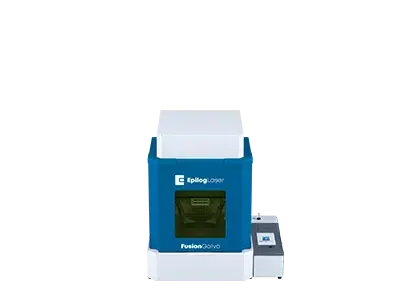
Fusion Galvo
Markierungsmaschine für MetallArbeitsbereichMaximal 6 x 6 Zoll
(152 x 152 mm)TypFaserlaser
Wattleistung30-100
(MOPA)Das Fusion Galvo ist das industrielle Metallkennzeichnungssystem von Epilog, das über einen anpassbaren Arbeitsbereich, blitzschnelle Geschwindigkeiten und das leistungsstarke IRIS™-Kamerasystem für eine schnelle und präzise Platzierung von Grafiken verfügt. -
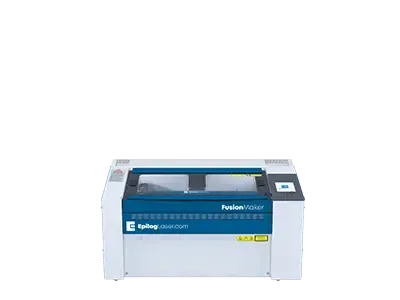
Fusion Edge 12
Business-SerieArbeitsbereich24 x 12 Zoll
(610 x 305mm)TypCO2, Faser
WattleistungCO2: 50-60
Ballaststoffe: 30Unser kompaktes Lasersystem ist in verschiedenen Wattkonfigurationen erhältlich und bietet bis zu 120 IPS/3,05 m/s Gravurgeschwindigkeit. Auch mit einer Faserlaserquelle erhältlich. -
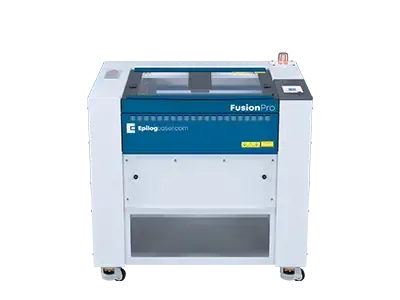
Fusion Pro 24
Industrial-SerieArbeitsbereich24 x 24 Zoll
(610 x 610 mm)TypCO2, Faser, Dual
WattleistungCO2: 60-100
Ballaststoffe: 60Der Pro 24 ist der kleinste unserer industriellen Fusion Pro Laser-Serie, er ist mit 60, 80 oder 100 Watt erhältlich und kann als Dual-Source-System mit CO2 - und Faserlaserfunktionen konfiguriert werden. -
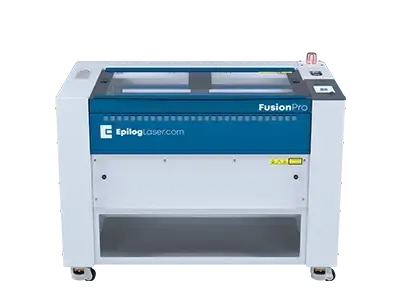
Fusion Pro 36
Industrial-SerieArbeitsbereich36 x 24 Zoll
(914 x 610 mm)TypCO2, Dual
WattleistungCO2: 60-200
Ballaststoffe: 30-60Wie alle Systeme der Fusion-Pro-Laserserie umfasst Pro 36 das IRIS-Kamerasystem von Epilog sowie Gravurgeschwindigkeiten von bis zu 165 Zoll pro Sekunde (4,2 m/s). -
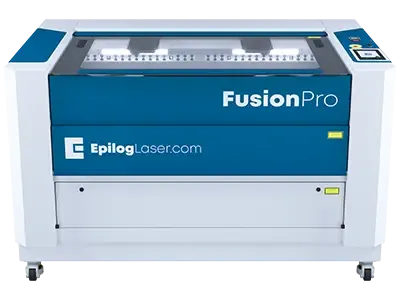
Fusion Pro 48
Industrial-SerieArbeitsbereich48 x 36 Zoll
(1219 x 914 mm)TypCO2, Dual
WattleistungCO2: 80-200
Ballaststoffe: 60Dieses Industriesystem ist das größte der Fusion Pros und in 80-, 100-, 120- und 200-Watt-Konfigurationen als Dual-Source-System erhältlich und kann über integriertes Ethernet, USB oder drahtlos vernetzt werden.
